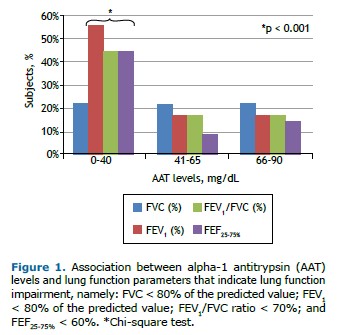TO THE EDITOR: Alpha-1 antitrypsin (AAT) deficiency is a genetic condition that predisposes those who have it to develop lung involvement in the form of emphysema and/or liver involvement in the form of cirrhosis or fibrosis.(1) AAT levels in routine clinical practice are requested as a starting point within the AAT deficiency diagnostic algorithm, without providing any type of information except for the quantitative point of view to define only the existence of that deficiency. To date, few studies have tried to relate AAT levels with possible alterations in pulmonary function parameters. Therefore, our objective was to study whether there was any type of association between AAT levels and functional parameters measured by spirometry.
We carried out a prospective study involving 1,510 consecutive subjects who sought the outpatient pulmonology clinic of our hospital for any reason and underwent blood workup and spirometry at the same visit. Patients were recruited during 54 consecutive months (between January of 2011 and June of 2015). Spirometric parameters were obtained with the use of a spirometer (Datospir 600; Sibelmed®, Barcelona, Spain). Pre- and post-bronchodilator spirometry was performed to obtain at least three acceptable and reproducible maneuvers according to standard quality criteria.(2) Four variables were used to define lung function impairment: FVC < 80% of the predicted value, FEV1 < 80% of the predicted value, FEV1/FVC ratio < 70%, and/or FEF25-75% < 60%.
Inclusion criteria were giving written informed consent, being able to perform spirometry successfully (three acceptable and reproducible maneuvers), and undergoing spirometry and determination of AAT levels in blood by nephelometry at the same visit. The final sample comprised 1,334 subjects, because 176 individuals did not meet the inclusion criteria. The study was approved by the research ethics committee of the institution (Protocol HGLaPalma_2010_7).
In the sample as a whole, 770 subjects were male (57.7%), the mean age was 56.4 ± 18.5 years, and the mean weight was 81.4 ± 18.6 kg. As for smoking status, 263 (19.7%) and 494 (37.0%) of the subjects were active and former smokers, respectively. The mean AAT level was 125.1 ± 31.9 mg/dL, and to 362 (27.1%) of the subjects presented with an obstructive pattern in spirometry (FEV1/FVC < 70%).
A statistical analysis of the relationship between AAT levels and lung function parameters showed a statistically significant association between the lung function parameters that are indicative of airflow obstruction and an AAT level < 40 mg/dL (χ2 = 22.61; p < 0.0001; OR = 5.46; 95% CI, 1.36-21.96; p < 0.05; Figure 1).

These results seem to show that patients with low AAT levels (0-40 mg/dL) are associated with altered lung function parameters in the form of airflow obstruction, and this interval would correspond to the most deficient genotypes (Pi*ZZ and some rare variants), a fact that is consistent with those collected in previous studies,(3) although, in the study by Tanash et al.,(4) the sample comprised children who had been exposed to tobacco smoke, a factor that is well known to be associated with significant deterioration of lung function.(5) However, considering AAT levels in the range of 41-65 mg/dL, the obstructive pattern was present in of 17.3% of the sample, which would mostly correspond to the Pi*SZ and Pi*MZ genotypes or some rare variants, showing how important it is to monitor these genotypes, especially when they are associated with smoking.(6) Other authors(7) found no relationship between AAT levels and lung function parameters measured by spirometry, although the cohort studied involved patients diagnosed with COPD, and genotyping in search of AAT deficiency alleles was not performed; therefore, it is impossible to rule out AAT deficiency in either of the studies.
In conclusion, this study shows that we must take into account AAT levels since, in addition determining whether a patient has AAT deficiency or not, they can guide us as to the probability of a patient developing lung function impairment.
AUTHOR CONTRIBUTIONS The authors equally contributed to this work.
CONFLICTS OF INTEREST None declared.
REFERENCES 1. Miravitlles M, Dirksen A, Ferrarotti I, Koblizek V, Lange P, Mahadeva R, et al. European Respiratory Society statement: diagnosis and treatment of pulmonary disease in α1-antitrypsin deficiency. Eur Respir J. 2017;50(5):1700610. https://doi.org/10.1183/13993003.00610-2017
2. Sociedad Española de Neumología y Cirugía Torácica (SEPAR). Manual SEPAR de Procedimientos, 3. Barcelona: SEPAR; 2002.
3. Pérez-Rubio G, Jiménez-Valverde LO, Ramírez-Venegas A, Camarena Á, Sansores RH, Flores-Trujillo F, et al. Prevalence of alpha-1 antitrypsin high-risk variants in Mexican mestizo population and their association with lung function values. Arch Bronconeumol. 2015;51(2):80-85. https://doi.org/10.1016/j.arbres.2014.09.010
4. Tanash HA, Nystedt-Düzakin M, Montero LC, Sveger T, Piitulainen E. The Swedish α1-Antitrypsin Screening Study: Health Status and Lung and Liver Function at Age 34. Ann Am Thorac Soc. 2015;12(6):807-812. https://doi.org/10.1513/AnnalsATS.201410-452OC
5. Janus ED, Phillips NT, Carrell RW. Smoking, lung function, and alpha 1-antitrypsin deficiency. Lancet. 1985;1(8421):152-154. https://doi.org/10.1016/S0140-6736(85)91916-6
6. Molloy K, Hersh CP, Morris VB, Carroll TP, O’Connor CA, Lasky-Su JA, et al. Clarification of the risk of chronic obstructive pulmonary disease in α1-antitrypsin deficiency PiMZ heterozygotes. Am J Respir Crit Care Med. 2014;189(4):419-427. https://doi.org/10.1164/rccm.201311-1984OC
Janciauskiene S, DeLuca DS, Barrecheguren M, Welte T, Miravitlles M; Scientific Committee; Par-ticipating sites and coordinators. Serum Levels of Alpha1-antitrypsin and Their Relationship With COPD in the General Spanish Population. Arch Bronconeumol (Engl Ed). 2020;56(2):76-83. https://doi.org/10.1016/j.arbr.2019.03.025


